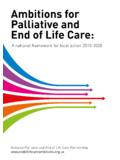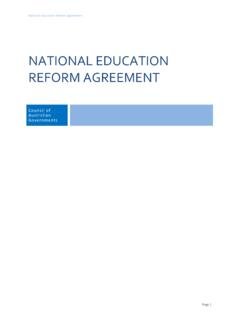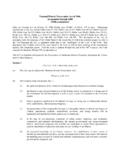Transcription of Accreditation guide - National Alliance of …
1 Accreditation guideFor peer Reviewers and ApplicantsJanuary 2018 Version EnrollmentNational Alliance ofPartnershipsadvancing quality college courses for high school students 2018 National Alliance of Concurrent Enrollment Partnerships, Inc. ABOUT NACEP The National Alliance of Concurrent Enrollment Partnerships (NACEP) works to ensure that college courses offered in high schools are as rigorous as courses offered on the sponsoring college campus. As the sole National accrediting body for concurrent enrollment partnerships, NACEP helps these programs adhere to the highest standards so students experience a seamless transition to college and teachers benefit from meaningful, ongoing professional development.
2 To advance the field and support our National network of members, we actively share the latest knowledge about best practices, research, and advocacy. Our National conference is the premier destination for college officials, high school leaders, policymakers, and researchers interested in creating an effective academic bridge between high school and college. Additional information can be found by visiting: 2018 National Alliance of Concurrent Enrollment Partnerships, Inc. National Alliance OF CONCURRENT ENROLLMENT PARTNERSHIPS Accreditation guide for peer Reviewers and applicants January 2018 | Version TABLE OF CONTENTS National CONCURRENT ENROLLMENT PARTNERSHIP STANDARDS .. 1 PURPOSE .. 3 BACKGROUND.
3 4 Program Accreditation .. 5 Intent of NACEP s Standards .. 5 Definitions .. 6 IMPORTANT CLARIFICATIONS FOR applicants AND REVIEWERS .. 7 Preparing a Well-Organized Application .. 10 NACEP Accreditation Eligibility Requirements .. 11 INSTITUTIONS OPERATING CEPs ACROSS MULTIPLE CAMPUSES .. 11 ORGANIZATION OF THE guide .. 12 PROGRAM DESCRIPTION .. 13 PARTNERSHIP STANDARD P1 .. 14 PARTNERSHIP STANDARD P2 .. 15 FACULTY STANDARD F1 .. 17 FACULTY STANDARD F2 .. Error! Bookmark not defined. FACULTY STANDARD F3 .. 19 FACULTY STANDARD F4 .. 21 ASSESSMENT STANDARD A1 .. 22 CURRICULUM STANDARD C1 .. 23 CURRICULUM STANDARD C2 .. 25 CURRICULUM STANDARD C3 .. 26 STUDENT STANDARD S1 .. 28 STUDENT STANDARD S2 .. 29 STUDENT STANDARD S3.
4 30 STUDENT STANDARD S4 .. 31 EVALUATION STANDARD E1 .. 32 EVALUATION STANDARD E2 .. 33 APPENDIX A Partnership Form .. 35 APPENDIX B Statement of Equivalency Guidelines .. 36 -1 - NACEP Accreditation guide National CONCURRENT ENROLLMENT PARTNERSHIP STANDARDS First Adopted April 2002 Revised May 2017 Effective 2018-19 Academic Year Partnership Standards Partnership 1 (P1) The concurrent enrollment program aligns with the college/university mission and is supported by the institution s administration and academic leadership. Partnership 2 (P2) The concurrent enrollment program has ongoing collaboration with secondary school partners. Faculty Standards Faculty 1 (F1) All concurrent enrollment instructors are approved by the appropriate college/university academic leadership and must meet the minimum qualifications for instructors teaching the course on campus.
5 Faculty 2 (F2) Faculty liaisons at the college/university provide all new concurrent enrollment instructors with course-specific training in course philosophy, curriculum, pedagogy, and assessment prior to the instructor teaching the course. Faculty 3 (F3) Concurrent enrollment instructors participate in college/university provided annual discipline-specific professional development and ongoing collegial interaction to further enhance instructors pedagogy and breadth of knowledge in the discipline. Faculty 4 (F4) The concurrent enrollment program ensures instructors are informed of and adhere to program policies and procedures. Assessment Standard Assessment 1 (A1) The college/university ensures concurrent enrollment students proficiency of learning outcomes is measured using comparable grading standards and assessment methods to on campus sections.
6 Version JANUARY 2018 -2 - Curriculum Standards Curriculum 1 (C1) Courses administered through a concurrent enrollment program are college/university catalogued courses with the same departmental designations, course descriptions, numbers, titles, and credits. Curriculum 2 (C2) The college/university ensures the concurrent enrollment courses reflect the learning objectives, and the pedagogical, theoretical and philosophical orientation of the respective college/university discipline. Curriculum 3 (C3) Faculty liaisons conduct site visits to observe course content and delivery, student discourse and rapport to ensure the courses offered through the concurrent enrollment program are equivalent to the courses offered on campus.
7 Student Standards Student 1 (S1) Registration and transcripting policies and practices for concurrent enrollment students are consistent with those on campus. Student 2 (S2) The concurrent enrollment program has a process to ensure students meet the course prerequisites of the college/university. Student 3 (S3) Concurrent enrollment students are advised about the benefits and implications of taking college courses, as well as the college s policies and expectations. Student 4 (S4) The college/university provides, in conjunction with secondary partners, concurrent enrollment students with suitable access to learning resources and student support services. Program Evaluation Standards Evaluation 1 (E1) The college/university conducts end-of -term student course evaluations for each concurrent enrollment course to provide instructors with student feedback.
8 Evaluation 2 (E2) The college/university conducts and reports regular and ongoing evaluations of the concurrent enrollment program effectiveness and uses the results for continuous improvement. -3 - NACEP Accreditation guide PURPOSE This guide is intended to provide consistent information to NACEP Accreditation peer Reviewers and applicants on the interpretation of NACEP s Standards, the range of acceptable practices, frequently asked questions about the Standards, and advice on assembling a well-designed Accreditation application to facilitate peer review. It is intended to help programs that are conducting self-studies in anticipation of applying for NACEP Accreditation in 2019 and beyond, and to guide programs currently holding NACEP Accreditation in the application of the revised standards coming into effect the 2018-19 school year.
9 This guide does not include a detailed description of the Accreditation process or timeline. The most up to date timeline, application instructions and forms can be found on the NACEP website. ACKNOWLEDGMENTS Initial brainstorming about this guide began when the then Accreditation Committee, Board of Directors, and NACEP membership engaged in discussions in 2008-2009 to revise NACEP s National Concurrent Enrollment Partnership Standards, first adopted in 2002. Becky Carter, Jan Erickson, Sandy Gonzalez, Karen Mills, and Dennis Waller met in Phoenix, Arizona in 2009 to begin putting together a framework for the guide . It became evident that the guide would need to reflect the newly adopted Standards in 2009 and has been updated once again due to the newly 2017 revised standards.
10 Thanks are due to the following Commissioners who worked on this edition for an extended amount of time: Victoria Zeppelin, Deanna Jessup, Robie Cornelious, Karen Landry, Bretton DeLaria, Katie Bucci, Christina Parish, Chelsie Rauh and Jeff Murphy. Suggestions for future editions should be directed to the NACEP Accreditation Commission Chair at Version JANUARY 2018 -4 - BACKGROUND A key concern of the leaders who established NACEP was the quality of college classes offered in high schools by concurrent enrollment partnerships. NACEP s members include some of the nation s oldest and most prominent concurrent enrollment partnerships, who share a common belief that institutions of higher education should follow certain best practices to ensure the quality of college classes taught by high school teachers.










